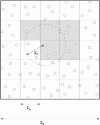Simulation of Sheared Suspensions With a Parallel Implementation of QDPD
- PMID: 27366609
- PMCID: PMC4853118
- DOI: 10.6028/jres.109.017
Simulation of Sheared Suspensions With a Parallel Implementation of QDPD
Abstract
A parallel quaternion-based dissipative particle dynamics (QDPD) program has been developed in Fortran to study the flow properties of complex fluids subject to shear. The parallelization allows for simulations of greater size and complexity and is accomplished with a parallel link-cell spatial (domain) decomposition using MPI. The technique has novel features arising from the DPD formalism, the use of rigid body inclusions spread across processors, and a sheared boundary condition. A detailed discussion of our implementation is presented, along with results on two distributed memory architectures. A parallel speedup of 24.19 was obtained for a benchmark calculation on 27 processors of a distributed memory cluster.
Keywords: dissipative particle dynamics; domain decomposition; mesoscopic modeling; parallel algorithms; rheology; spatial decomposition; suspensions.
Figures










References
-
- Hoogerbrugge PJ, Koelman JMVA. Simulating Microscopic Hydrodynamic Phenomena with Dissipative Particle Dynamics. Europhys Lett. 1992;19(1):155.
-
- Español P, Warren P. Statistical mechanics of dissipative particle dynamics. Europhys Lett. 1995;30:191.
-
- Marsh C, Backx G, Ernst MH. The Fokker-Planck-Boltzmann equation for dissipative particle dynamics. Europhys Lett. 1997;38:441.
-
- Martys NS, Mountain RD. Velocity Verlet algorithm for dissipative-particle-based models of suspensions. Phys Rev E. 1999;59(3):3733.
-
- Verlet L. Computer “experiments” on classical fluids. I. thermodynamical properties of lennard-jones molecules. Phys Rev. 1967;165:201.
LinkOut - more resources
Full Text Sources
Other Literature Sources
